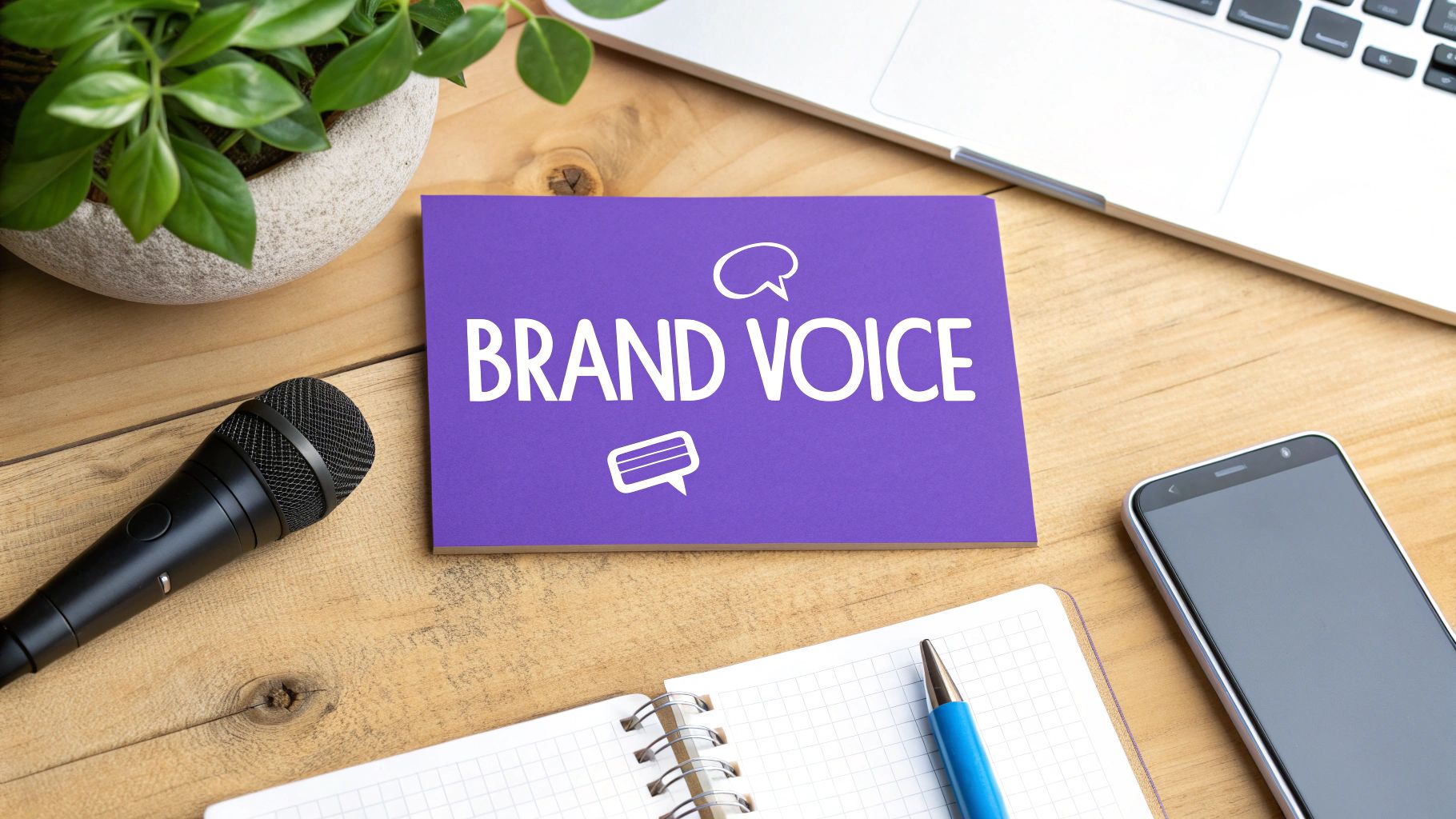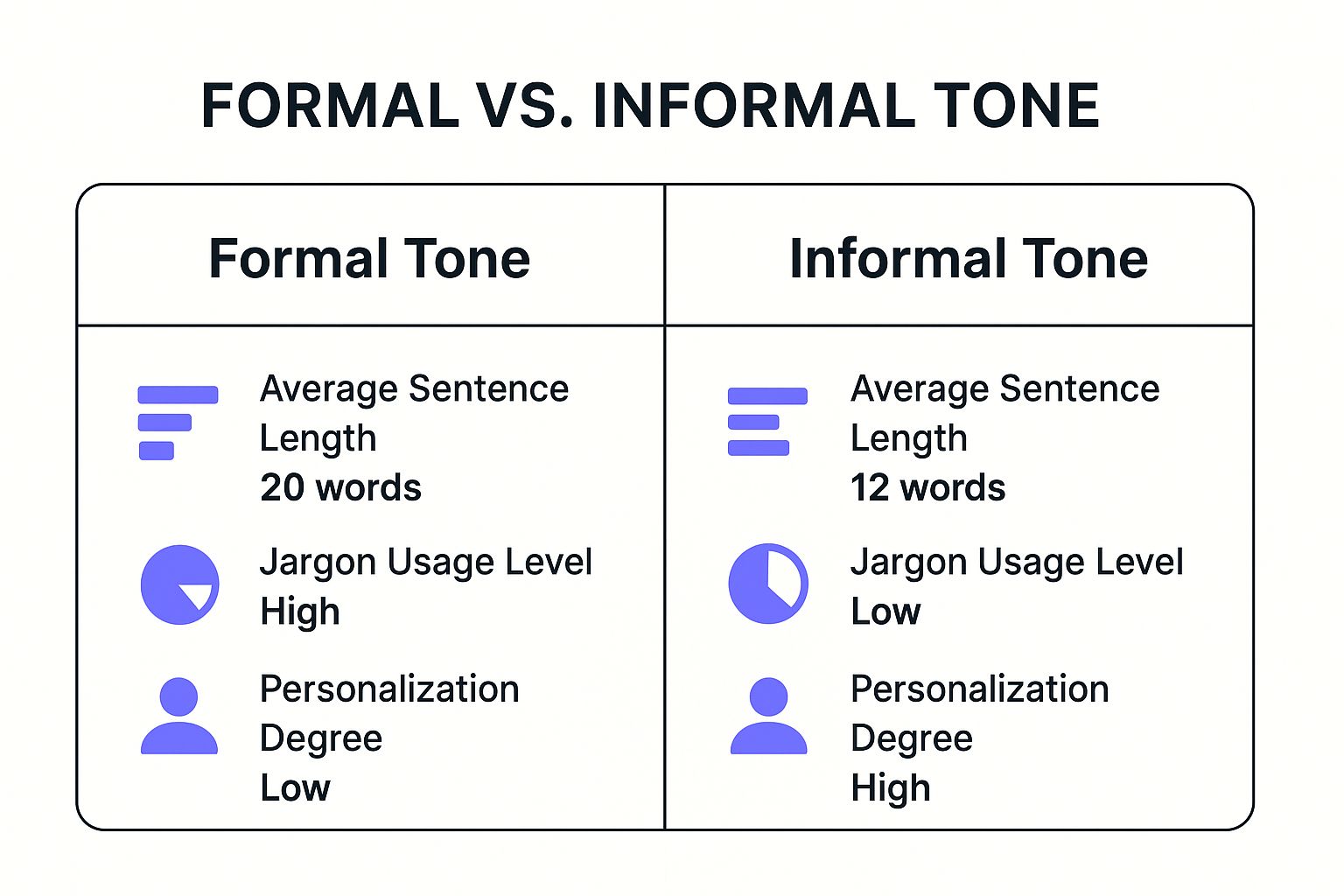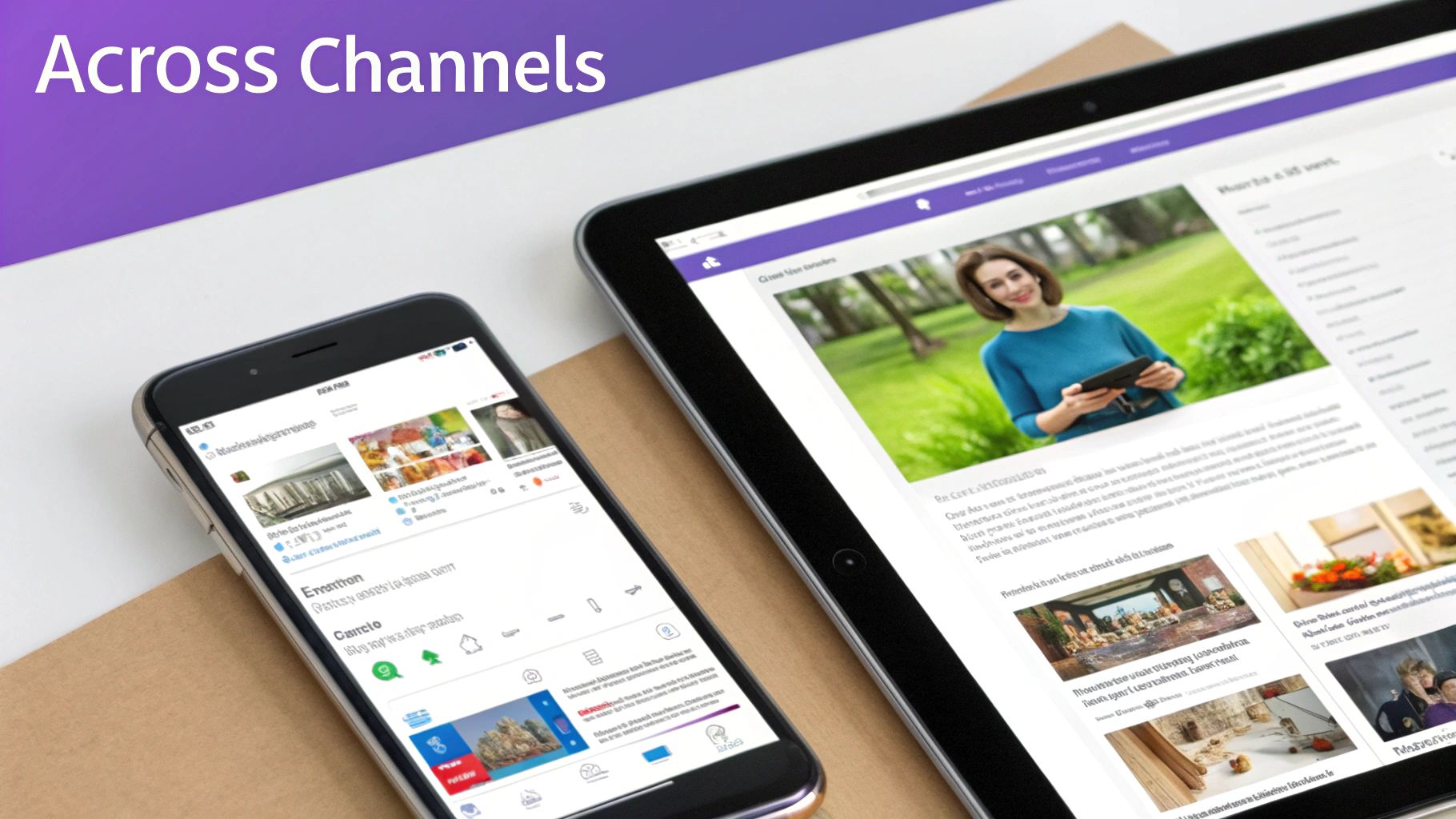Brand Voice Guide: Build Authentic Connections That Convert

Why Your Brand Voice Matters More Than You Think
Think about the people you know best. You can probably recognize them just by the way they speak—their unique rhythm, go-to phrases, and the personality that shines through their words. A strong brand voice works the same way. It's the distinct personality that makes your company recognizable, even in a sea of competitors.
Many businesses make the mistake of thinking brand voice is a simple choice between "professional" and "casual." But it goes much deeper than that. It’s the consistent character that connects every single piece of your communication, from website copy and social media posts to customer support emails.
When this character is consistent, it transforms simple interactions into memorable experiences. Without a defined voice, your marketing can feel confusing. Imagine a witty tweet one day followed by a formal, stiff email the next. This inconsistency chips away at the most important ingredient for growth: trust. A clear brand voice ensures every touchpoint feels familiar and dependable, building a sense of reliability that customers value.
The Foundation of Customer Trust
Building trust isn’t just a nice-to-have goal; it's a fundamental driver of business success. Brand voice has a direct effect on how consumers perceive your brand and their decision to buy from you. Research shows that 81% of consumers need to trust a brand before they will make a purchase.
This trust is built on the consistency and clarity of your communication. It’s so important that companies often dedicate 10% to 20% of their marketing budgets to branding activities that sharpen their identity. As you can see from this data on the impact of branding on consumer trust, a cohesive brand voice isn't a fluffy extra—it’s a strategic asset.
Differentiating Voice from Tone
To build this kind of consistency, it's vital to understand the difference between brand voice and brand tone. They might seem similar, but they play very different roles.
- Brand Voice: Think of this as your brand's core personality. It’s fixed and doesn’t change. Are you a wise expert, a supportive friend, or a high-energy motivator? This is the "who" of your brand.
- Brand Tone: This is the emotional flavor you add to your voice for different situations. It’s flexible and adapts to the context. You wouldn't use the same tone to announce an exciting new feature as you would to respond to a customer's problem, but both messages should still clearly come from your core voice.
Here’s a simple analogy: Your voice is who you are, but your tone is your mood. While a Wikipedia entry on branding shows that a brand is made of many parts, the voice is what gives it a human feel.

This image illustrates that a brand is a mix of names, designs, and symbols. Your brand voice is what breathes life into these elements. By understanding the interplay between your unchanging voice and your adaptable tone, you can make sure every message reinforces who you are and strengthens your connection with customers.
The DNA of Powerful Brand Communication

What makes some brands sound effortlessly authentic while others feel like they're reading from a script? The secret is in their communication DNA. Just like your genetic code shapes your unique traits, a brand's voice is built from four core elements that define its identity. A complete brand voice guide depends on mastering these components. When combined thoughtfully, they create a personality that feels genuine and connects with your audience on a deeper level.
Think of these elements as the essential building blocks of every message you send. Getting them right is the difference between being memorable and just being noise.
The Four Pillars of an Authentic Voice
To go from a vague idea of your brand's voice to a concrete personality, you need to understand the distinct role each element plays. They work together, layering to form a cohesive and recognizable character that resonates with customers. Let's break down these foundational pillars.
To help visualize how these elements work together, here's a detailed breakdown of each pillar, its role, and how it shows up in real-world communication.
| Voice Element | Description | Audience Impact | Implementation Examples |
|---|---|---|---|
| Personality | The "who" of your brand. It’s the set of human characteristics and traits that define your brand’s character. | Makes the brand relatable and memorable, fostering a human-like connection. | A brand like Innocent Drinks adopts a "quirky and playful" personality, using puns and informal language. A brand like Rolex embodies a "sophisticated and authoritative" personality with formal, precise language. |
| Communication Style | The "how" of your communication. This covers the mechanics of your language, such as sentence structure, vocabulary, and rhythm. | Influences readability and accessibility, making content either easy to digest or more complex and formal. | Mailchimp uses a simple, encouraging style with short sentences, making complex tools feel approachable. A legal firm might use a formal style with complex sentences to convey expertise. |
| Emotional Resonance | What you want your audience to feel. It’s the specific emotional response your words are designed to create. | Builds a deeper, value-based relationship that goes beyond the transactional. | Patagonia’s voice aims to inspire a sense of responsibility and adventure, making a purchase feel like a stand for environmental values. A security company might aim to make customers feel secure and protected. |
| Value Expression | The "why" behind your brand. This involves consistently weaving your core mission and values into your messaging. | Creates loyalty by showing customers you share common ground and stand for something more than just profit. | A brand committed to sustainability, like Allbirds, frequently mentions eco-friendly materials and ethical production in its messaging. |
By mastering these four pillars, you create a foundation for a voice that is not only consistent but also powerful enough to build a loyal community around your brand.
Aligning Tone with Audience Expectations
While these four elements form your consistent voice, the specific tone you use can—and should—adapt. This adaptability is critical for meeting audience expectations in different situations.
For instance, a 2025 global survey found that a 'warm and inviting' tone was considered extremely or very influential by 61% of audiences. Similarly, a 'historied and trusted' tone resonated with 60% of people, while a 'modern and innovative' one was influential for 56%. This data shows that choosing a tone that aligns with your brand’s personality and what your audience wants to hear is a powerful strategy. You can find more details in this analysis of winning brand strategies.
By carefully defining and combining these four DNA elements, you can develop a guide that ensures your brand speaks with an authentic, consistent, and powerful voice across every channel.
Three Proven Frameworks That Actually Work
Trying to build a brand voice from scratch can feel like a major creative hurdle, but you don't have to start with a blank page. The most memorable brands often use established frameworks to guide their process. These structured methods turn the abstract idea of "personality" into a series of clear, strategic steps. A solid framework is the bedrock of an effective brand voice guide, making sure the final voice is both authentic and intentional.
Instead of just guessing what might resonate, a proven model gives you a reliable roadmap. It helps you ground your creative choices in solid information about your audience, your place in the market, and your core company values. Let’s walk through three powerful frameworks that can help you define a voice that genuinely connects with your customers.
The Brand Personality Framework
This framework asks you to think of your brand as if it were a person with specific character traits. Rather than just picking random adjectives, it uses psychological principles to build a deeper, more consistent personality. Think of it as creating a detailed character profile for your business. The aim is to move past surface-level words like "friendly" and get to the core motivations and values that drive your brand.
To put this into practice, you can explore archetypes or personality spectrums. For example, is your brand a wise expert or a rebellious innovator? Is it nurturing and supportive, or witty and a bit provocative?
- Identify Core Traits: Start by choosing three to five core traits that define your brand’s character (e.g., Confident, Empathetic, Witty).
- Define with Nuance: For each trait, explain what it is and what it isn't. For example, "Confident, not arrogant. Witty, not sarcastic." This clarity is crucial for consistency.
- Connect to Action: Link each trait to specific communication habits, such as vocabulary, sentence structure, and the type of humor you use.
The Audience-First Method
The Audience-First Method flips the traditional approach on its head. Instead of starting with what you want to say, it begins with a deep dive into who you're talking to. The central idea here is simple: your voice will only work if it resonates with the people who are most important to your business. A brand that feels out of touch with its audience will find it hard to build the trust needed for lasting loyalty.
This method is built on research. You need to go beyond basic demographics and explore psychographics—your audience's values, preferences, pain points, and communication styles. How do they talk to their friends? What kind of content do they actually enjoy?
- Develop Audience Personas: Create detailed profiles of your ideal customers.
- Analyze Their Language: Use social listening, surveys, and customer interviews to study how they communicate.
- Mirror and Align: Shape your voice to mirror their language patterns and address their needs in a way that feels natural and familiar to them.
The Competitive Differentiation Framework
In a crowded market, sounding just like everyone else is a fast track to being ignored. This framework is all about carving out a unique space for your brand by analyzing how your competitors communicate. The goal isn't to copy what they do but to find gaps and opportunities to sound different. Your brand voice becomes a strategic differentiator.
Start by auditing the communications of your top two or three competitors. Map their voices on a spectrum: Are they formal or informal? Humorous or serious? Overly technical or refreshingly simple? This analysis will quickly reveal common patterns and overused approaches.
To help you choose the right framework for your needs, here's a quick comparison of the three methods we've discussed.
| Framework | Primary Focus | Time Investment | Best For | Key Benefits |
|---|---|---|---|---|
| Brand Personality | Building an authentic, character-driven identity from internal values. | Moderate | Brands wanting a strong, memorable personality that stands the test of time. | Creates deep consistency and a human-like connection with the audience. |
| Audience-First | Aligning the brand's voice with the target audience's language and preferences. | High (Research-intensive) | Businesses in niche markets or those serving a very specific customer base. | Ensures high resonance and builds strong community trust. |
| Competitive Differentiation | Creating a unique voice by identifying and filling gaps in the market. | Low to Moderate | Companies entering crowded markets or looking to stand out from established players. | Provides a clear market position and makes the brand instantly recognizable. |
Ultimately, the best framework depends on your specific goals. If you're building a brand for the long haul, the Personality Framework offers a solid foundation. If market resonance is your top priority, the Audience-First Method is your best bet. And if you need to make a splash in a busy industry, the Differentiation Framework will help you find your unique sound.
This infographic shows how tangible data points like sentence length and jargon can represent a formal versus an informal tone.

The visualization makes it clear how a brand's choice of tone directly affects the complexity and accessibility of its message. By figuring out where your competitors land on this spectrum, you can strategically position your voice to meet a need in the market—perhaps by being the refreshingly simple voice in an industry filled with jargon.
Brand Voice Success Stories That Drive Results

Theory and frameworks are a great starting point, but seeing how successful brands use these principles in the real world makes the ideas click. The real power of a well-defined voice isn't just about sounding good—it’s about driving real business results. A strong brand voice guide is the tool that makes this consistency possible.
Let's look at how three very different companies have mastered their voices, turning personality into profit and connection into loyalty. Each example shows the strategic thinking behind their communication, offering lessons you can use for your own brand.
Nike: The Voice of Aspiration and Action
Nike doesn't just sell sportswear; it sells motivation. Its voice is bold, inspirational, and empowering. Think of it as a mix between an elite athlete and a determined coach, speaking directly to the potential inside every person. This voice is more than a marketing tactic; it's a core asset that forges a deep emotional connection with customers.
This approach lets Nike compete on feeling rather than just product features. When you buy a pair of running shoes, you’re not just getting footwear; you’re buying into the "Just Do It" mindset. This iconic slogan captures Nike's assertive and inspirational voice, empowering consumers and solidifying its leadership in the athletic industry. You can see how this strategy boosts engagement by learning more about the strategies of top-tier brands.
Slack: Making Work Simpler and More Human
Slack entered a market crowded with complicated, jargon-filled business software. It stood out by creating a voice that is approachable, clear, and empathetic. Instead of sounding like a cold, corporate machine, Slack sounds like a helpful coworker. Its communication avoids technical terms, using simple language that makes its powerful features feel easy to use.
The business impact of this friendly voice is huge.
- Fewer Support Tickets: By using clear language in its interface and help guides, Slack answers questions before users even have to ask, reducing the load on its support team.
- Faster User Adoption: A welcoming, non-intimidating voice encourages new users to explore the platform without feeling overwhelmed. This leads to quicker and broader adoption within companies.
- Deeper Brand Affinity: This human-centered voice has built a loyal community. Users don't just use Slack; they often express real affection for it, which is rare for a business-to-business software company.
Starbucks: The Digital Extension of a Cozy Corner
Starbucks perfected the idea of the "third place"—a warm, welcoming spot between home and work. Its challenge was to bring that same feeling to its digital channels. The company’s brand voice is designed to be warm, personal, and community-focused, creating a smooth experience from the physical café to the app.
Whether you're reading an email about a new drink or getting a notification, the language echoes the cozy atmosphere of their stores. The voice is consistent, making every digital interaction feel like a natural extension of the in-person one. This strategy builds loyalty beyond just coffee, making customers feel like they are part of a familiar and inviting community, no matter where they are.
Building Documentation That Your Team Will Actually Use
An amazing brand voice strategy means nothing if it’s trapped in a PDF that collects digital dust. Here’s a hard truth: most brand guidelines get a quick look and are then forgotten. The difference between a voice that creates consistency and one that becomes expensive shelf-ware is documentation built for how people actually work. A guide your team will use needs a careful balance—it must be specific enough to avoid confusion but simple enough to be a daily tool, not a chore.
A truly useful brand voice guide goes beyond vague adjectives. Instead of just saying your brand is "friendly," it shows what "friendly" looks like in action. This means providing clear, practical examples that content creators, marketers, and support agents can reference in a hurry. This hands-on approach is what turns a theoretical rulebook into a core part of your team's workflow. When guidelines are clear and easy to apply, consistency feels natural instead of forced.
From Abstract Concepts to Concrete Rules
The most effective guides translate high-level personality traits into clear do's and don'ts. This is where you make your voice tangible and easy to grasp. Think of it as creating a "cheat sheet" that removes the guesswork for your team.
A brand voice chart is a fantastic tool for this. It connects a core voice characteristic to specific examples, making it simple for anyone in the company to understand and apply the rules.
| Voice Characteristic | Do | Don't |
|---|---|---|
| Confident | Use active voice and state facts directly. "Our software helps you finish tasks faster." | Use passive voice or vague language. "It is thought that our software may help..." |
| Empathetic | Acknowledge customer frustrations and offer solutions. "We understand that's frustrating. Let's get this sorted out for you." | Use dismissive or generic corporate phrases. "We apologize for the inconvenience." |
| Witty | Use clever wordplay or light humor relevant to your industry. "Stop wrestling with spreadsheets. There's a better way." | Use sarcasm, memes that might be misinterpreted, or jokes that could alienate part of your audience. |
This straightforward structure helps prevent the most common problems with voice consistency. Since 81% of consumers need to trust a brand before buying, inconsistent communication is a fast way to break that trust. By providing clear examples, you empower your team to maintain that trust in every interaction.
Making the Guide Accessible and Actionable
Even the best rules won't be followed if they are hard to find. To make sure your brand voice guide is actually used, weave it into your team’s existing processes. Don't just email a file and cross your fingers.
Here are a few ways to make your documentation impossible to ignore:
- Create a Central Hub: Use a shared internal platform like Notion, a company wiki, or a collaborative tool like the one offered by Mural to host your guide. This ensures everyone is working from the latest version.
- Build Templates: Develop pre-approved templates for common content types—like social media posts, blog intros, and customer service emails—that already have the brand voice built-in.
- Include It in Onboarding: Make reviewing the brand voice guide a required step for all new hires, especially those in marketing, sales, and customer-facing roles.
By documenting your voice with specific examples and making those guidelines an active part of your team's daily environment, you ensure your brand speaks with one clear, compelling, and consistent voice.
Making Voice Consistency Happen In Real Life
A brilliant brand voice guide is only half the battle. Its real value comes to life when your team applies it consistently across every email, social media post, and customer interaction. Many businesses stumble here, facing a frustrating gap between a sharp strategy and messy day-to-day execution. Success means weaving the voice into your company’s culture, making it a natural reflex, not just another task on a checklist.
Think of it like learning a new language. One lesson won’t make you fluent; you need daily practice, real-world application, and a supportive environment. The same goes for your brand voice. To move from theory to consistent practice, you need a deliberate plan that combines training, quality checks, and ongoing measurement into your team’s daily work. This is a vital part of any effective brand voice guide.
Effective Team Training and Rollout
Simply emailing a PDF of your new guidelines and hoping for the best is a recipe for failure. To make your brand voice stick, you need to create an immersive learning experience that builds lasting habits.
- Interactive Workshops: Ditch the one-way presentation and run hands-on workshops instead. Ask your team to rewrite existing content—like sales emails or help articles—using the new voice. This active practice builds practical skills and confidence.
- Create Voice Champions: Find enthusiastic team members from different departments (marketing, sales, support) to be your voice champions. They can offer peer-to-peer coaching and act as the go-to people for questions, making the voice feel like a shared effort.
- Ongoing Reinforcement: Consistency isn’t built overnight. Celebrate "voice wins" in team meetings, share great examples in a dedicated Slack channel, and give regular, constructive feedback to reinforce good habits.
Systems for Quality Control and Accountability
To keep standards high without slowing everyone down, you need a smart quality control system. This isn't about micromanaging every word; it's about creating a safety net that catches major mistakes before they reach your audience. For example, you could start a simple peer-review process for high-impact content like blog posts or major announcements.
Accountability is just as important. Set clear expectations for who is responsible for voice consistency in different areas. A straightforward review process can keep everyone on the same page.
| Review Stage | Who Is Responsible? | Key Focus |
|---|---|---|
| Initial Draft | Content Creator | Following core voice characteristics (e.g., personality, tone). |
| Peer Review | Team Member/Voice Champion | Checking for clarity, consistency, and alignment with do's/don'ts. |
| Final Approval | Marketing/Content Lead | Final check on strategic messaging and brand alignment. |
Adapting Your Voice for Different Channels
While your core voice—your brand’s personality—should always stay the same, your tone needs to adjust to the context of different channels. You wouldn’t use the same formal tone from a whitepaper in a casual Instagram story. Your guide should give clear advice on how to adapt the voice.
- Social Media: Often requires a more conversational, brief, and sometimes playful tone.
- Customer Support: Needs an empathetic, patient, and problem-solving tone.
- Formal Reports: Calls for a more authoritative, data-focused, and structured tone.
By offering clear examples for each channel, you give your team the power to make smart tonal shifts while staying true to your brand's core identity. This is how you turn your brand voice into a living, breathing part of your organization that builds trust and connection with every interaction.
Your Step-By-Step Brand Voice Action Plan
Turning big ideas into a solid plan is the final, most important part of this brand voice guide. A well-defined voice only delivers results when it's put into practice. This action plan breaks down the development and rollout into clear phases, helping your brand’s personality shift from a document into a living, breathing part of your company. Think of this as a practical toolkit for building a voice that truly connects and endures.
Phase 1: Research and Discovery (Weeks 1-2)
The secret to an authentic voice is understanding. Before you can define your brand's personality, you need to listen closely. This first phase is all about collecting the insights that will shape every decision you make moving forward.
- Audit Your Current Voice: Take a close look at your existing content across all channels—from your website and social media to your emails. What patterns do you notice? Is your voice consistent, or does it change from one platform to another?
- Analyze Your Audience: Go deeper than just demographics. Use surveys and social listening to understand how your ideal customers actually talk, what they value, and what challenges they face.
- Map the Competition: Pick your top three competitors and analyze their brand voices. This will help you spot overused tones and find a unique space for your brand to stand out.
Phase 2: Framework and Definition (Weeks 3-4)
With solid research in your back pocket, it’s time to give your brand a distinct character. This is where you’ll pick a framework and establish the core attributes of your voice.
- Choose Your Framework: Decide which approach works best for your goals. Will you use the Brand Personality, Audience-First, or Competitive Differentiation framework? You can even create a hybrid that combines elements of each.
- Define Voice Characteristics: Select 3-5 core personality traits for your brand (e.g., Confident, Empathetic, Witty). For each one, create a "This, Not That" statement to add clarity, such as, “Confident, not arrogant.”
- Create a Voice Chart: Build a simple table that outlines the do's and don'ts for each characteristic. Provide clear, real-world examples of how the voice should sound in different situations.
Phase 3: Documentation and Rollout (Weeks 5-8)
A brand voice is only effective if your team uses it consistently. This phase is all about creating helpful documentation and training everyone to apply it correctly.
- Build the Guide: Gather your voice characteristics, charts, and channel-specific tone guidelines into a single, easy-to-access document.
- Conduct Team Training: Hold interactive workshops where team members can practice rewriting content in the new voice. Appoint voice champions who can offer ongoing support and guidance.
- Integrate and Measure: Make the guide a standard part of your onboarding process and content creation workflows. Set up a simple review system and track metrics to see how the new voice is affecting engagement.
Ready to build a powerful online presence that reflects your new voice? MakerBox can instantly generate professional bios, captivating social media content, and striking profile photos that align with your brand's unique character. See how thousands of professionals are transforming their profiles and start building your standout brand with MakerBox today.





